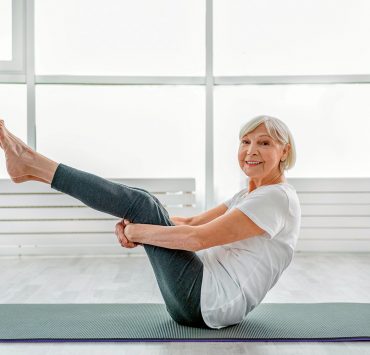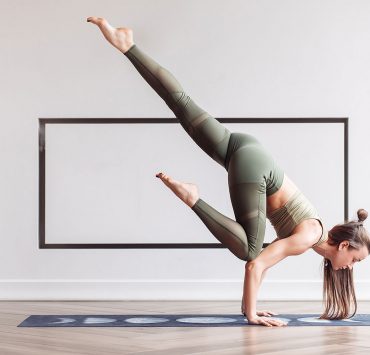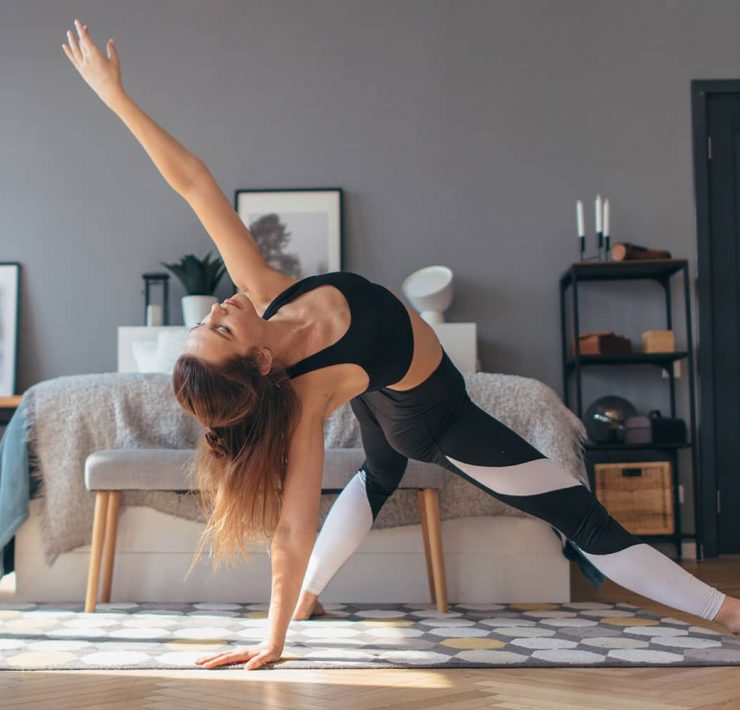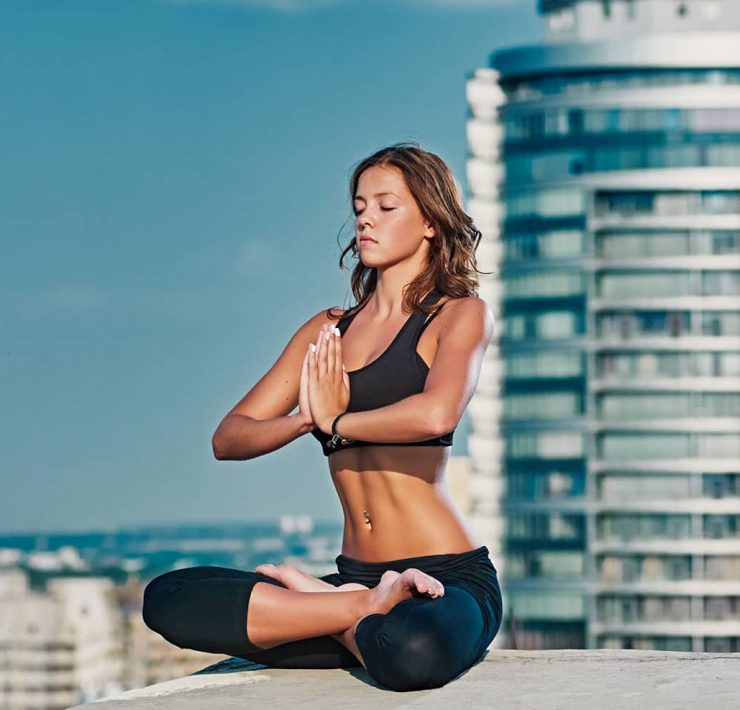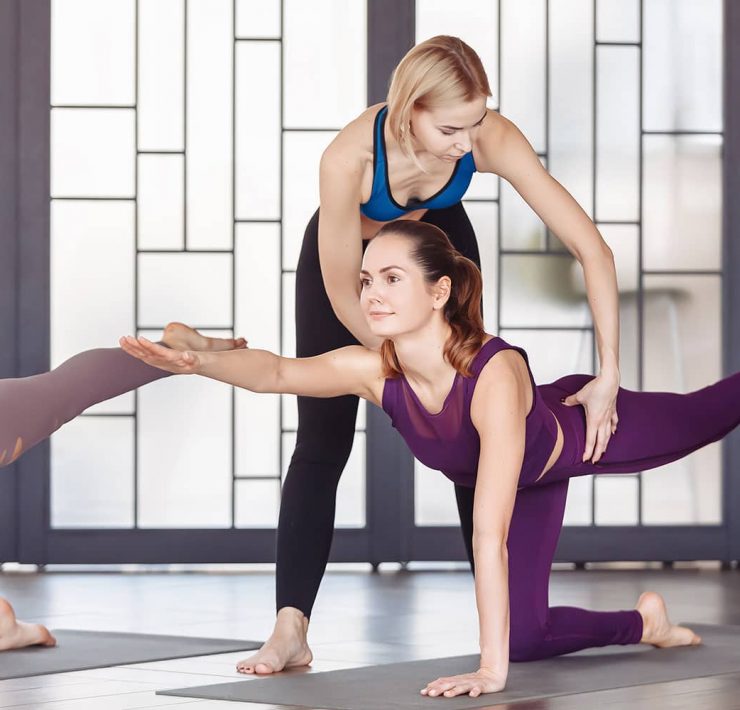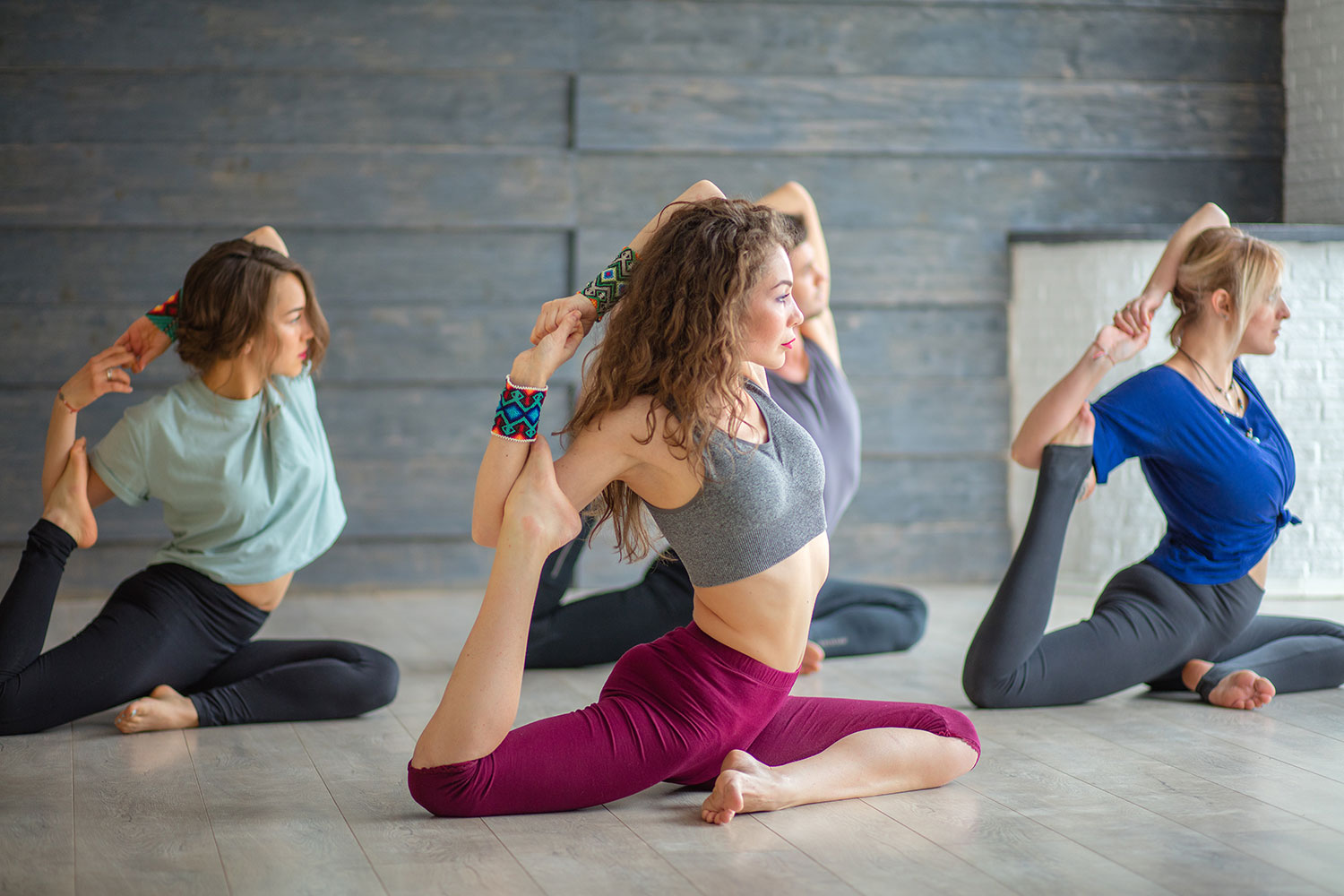
Rose graduated with a degree in Anthropology, which takes her…
Whether you are a newly certified vinyasa yoga teacher, or a long seasoned yoga teacher, you can always become a better teacher. Truly, the best teachers are the ones who remain students and continue to connect with the lineage of the practice. There is no one “right” way to teach a vinyasa yoga class. Every teacher has their own style and will connect with students in a unique way. Yoga teachers may even change and adjust their teaching style over time as they become more in tune with their own voices.
Yoga teachers must be willing to step down from this imagined pedestal and utter the words “I don’t know” on a regular basis. Gudjon Bergmann
However, there are definitely some foundations that all vinyasa yoga classes should share, and some similarities among the best vinyasa yoga teachers. Below we are discussing some of the staples behind vinyasa yoga and how to teach a kick-ass vinyasa yoga class.
What Is Vinyasa Yoga?

Although every vinyasa yoga class is different, there are some basic characteristics that all vinyasa classes should share. First, a vinyasa refers to a flowing yoga practice that is lead by the breath. In Sanskrit, vinyasa directly translates to “to place in a special way.” However, Western yogis more typically refer to vinyasa as “flow yoga.” Vinyasa yoga is a broad umbrella term for specific types of yoga such as Ashtanga yoga or power yoga, which both use breath to link a flowing sequence.
Besides referring to the overall flowing nature of a class, ‘vinyasa’ also refers to a specific flow sequence that is included in all vinyasa classes. A vinyasa is the transition from plank to chatturanga to up dog to down dog, which typically occurs between sun salutations or different sets of poses. The use of a vinyasa makes vinyasa classes dynamic, energizing, and sometimes even aerobic.
When looking at the history of vinyasa yoga, it dates back to the hatha yoga system. Back in 200 B.C. Patanjali wrote his yoga sutras, solidifying the eight limbs of yoga, and the concept that yoga poses (asanas) should be linked with breath. Over the last centuries, this type of yoga has changed and evolved to include more movement and flow, in the style that modern yogis recognize as vinyasa.
Teaching Vinyasa Yoga

Vinyasa yoga is a particularly popular style of yoga, especially in the West. However, this definitely presents some challenges to teaching a high quality vinyasa yoga class. For example, vinyasa yoga can be very physically demanding, and as such it is offered in many gyms. Due to this environment, vinyasa yoga classes may attract many students who aren’t aware of the deep spiritual traditions of yoga, but rather just come to class wanting a good workout. Balancing the individuality and goals of each student, whilst retaining the integrity of a centuries old spiritual tradition, can be extremely challenging for both the novice and experienced vinyasa yoga teacher. Below are ten tips for yoga teachers looking to teach the best vinyasa yoga class they can.
Include A Grounding, Warm Up, Main Sequence, Restorative Poses, And Savasana

Sequencing a good vinyasa yoga class is usually the biggest challenge on new teachers’ minds. To sequence a really great yoga class (the kind that students leave thanking you and looking completely blissed out) is a skill. However, this skill can be honed and refined by following some basic steps. Every good vinyasa yoga class should follow the basic structure of:
Grounding:
This will focus and calm students’ energy before beginning the full sequence. It may include poses like child’s pose, easy pose, mountain pose, and more.
Warm up:
About one quarter to one third of the class should be a warm up. Typically in a vinyasa class the sun salutations are used to warm up the major muscle groups.
Main sequence:
The main sequence makes up the middle bulk of the class, and should include a flow of poses on both sides of the body, usually repeated at least once. A good flow will have a specific goal in mind (such as detoxifying, opening hips, opening the chakras, and more).
Restorative poses:
After the main sequence, it is important to cool down both physical and energetically with restorative poses. These poses typically occur on the mat and are held for longer periods of time, such as bound angle pose, shoulder stand, wheel pose, and more.
Corpse Pose (Savasana):
Each vinyasa yoga class traditionally closes with corpse pose, where students lie flat on their back. This can last from one minute up to 15 minutes or even more, depending on the total length of the class.
Sequencing a great vinyasa yoga class is truly a work of art. It involves both mindful planning and engineering of poses that work well together and create a cohesive class, as well as the ability to intuitively tune into students’ needs.
Keep Track Of The Time

Every yoga teacher and student has probably had the experience of someone rushing into class late, and disrupting the energy of the room. If teachers are to expect students to arrive on time, they must also respect the students’ time at the end of class. It is very important for yoga teachers to end class on time. This sends a message to students that the teacher respects and honors them. To end on time, the yoga teacher must keep track of time throughout the class, and be sure that every step of the class sequence is given proper time. For example, rushing through restorative poses or savasana because there are only five minutes left in the class will have students feeling ungrounded and hyped up when they leave class. To keep track of time, the yoga teacher could discreetly check a clock in the studio, or wear a watch on their wrist.
Offer Modifications

Chances are, not every student in your vinyasa yoga class is going to be the exact same level and have the exact same ability in all poses. Mixed-level classes are beautiful environments where yogis can learn and benefit from one another. However, they do provide a challenge to teachers, who must teach a class that is accessible to the beginning yogis, yet still challenging to the physically advanced yogis. One way to do this is to always provide modifications to yoga poses. Ideally, the ‘easy’ or modified version of the pose should be taught first, and then options to make the pose more challenging. It is then up to the students to try each harder variation and find their own level. By teaching the modified version first, the yoga teacher is able to avoid beginning students attempting very advanced poses straight away and potentially injuring themselves. Ultimately, the teacher must be aware of who is in the room and always teach to the students’ level on any given day.
Use Natural And Safe Transitions

Due to the flowing nature of a vinyasa yoga class, it is full of transitions between poses. Unfortunately, transitions are the most common place for injuries to happen during a yoga class. It is therefore very important for the yoga teacher to always teach natural and safe transitions. For example, it is safer to transition from a closed-hip pose to another closed-hip pose. Transitioning from closed to open to closed again increases risk for injury. The yoga teacher should also be aware of typical misalignments in transitions, such as dumping into the shoulders during chatturanga or not placing the back foot flat on the mat in warrior I. An easy way to ensure safe transitions, in addition to anatomical knowledge, is for the yoga teacher to practice transitions themselves before class and make sure they feel natural.
Speak Clearly And Calmly

A yoga teacher cannot teach if their students cannot hear them. Mumbling or speaking quietly, no matter how profound or wise your words, will always distract yoga students from the class at hand. One easy way to up your yoga teacher game is to ensure you speak clearly and calmly. Be sure to enunciate and project your voice as the more bodies in the room, the more sound is absorbed.
Make Each Pose Have An Intention

Sequencing a good vinyasa yoga class is truly an artistic act, but that doesn’t mean just any pose should be thrown into the mix. A good yoga teacher should choose each pose with intention, and keep an eye on the big picture of the whole class. For example, if the class has a focus on emotional openness and vulnerability, then hip opening poses such as warrior II, wide angle forward fold, and half moon pose should be used. Mixing in a closed hip pose such as warrior III will likely confuse the sequence and inhibit the original goal. Whatever poses the teacher ultimately chooses to include, they should be wary of their goals in choosing the pose: Is that pose advancing the overall sequence?
Teaching yoga itself is great karma yoga, because it reconnects people to the source. Amit Ray
How does it fit in with the previous pose? How are students energetically reacting to this sequence? These are the kind of questions a good teacher will consider as they are teaching.
Tune Into Your Students

Similarly to the previous point, a good vinyasa yoga teacher needs to be flexible, spontaneous, and most importantly intuitively tune into their students. As important as it is to provide a well sequenced class with safe transitions, a yoga teacher also shouldn’t walk into the room and teach a pre-sequenced class. As good of a class as they might have planned out, a grounding and calming class will do no good for a room of students who are already feeling sluggish and low on energy. Instead, the yoga teacher should be able to walk into that room and design a sequence around the students who are present, their ability level, and their energetic and emotional needs in that moment. Although this is difficult to do, the yoga teacher will notice that over time they will have a battery of safe transitions and better be able to tune into their students needs.
Be True To Your Individual Voice

As a yoga teacher, it can be tempting to rely on the soft, breathy ‘yoga teacher voice’ to impart a sense of wisdom to your words. In addition, new teachers may be tempted to copy phrases from their favorite teachers and to model their own classes after other teachers’ classes. It is true that imitation is the truest form of flattery, but how is this serving the yoga students? Ultimately, if the yoga teacher is not true to their own unique voice, then the yoga students will be receiving an inauthentic class.
Even the Master, in one way or another, is a student throughout life. Fakeer Ishavardas
Although it is a challenge that requires both deep personal introspection, and time to practice, it is very important for yoga teachers to be true to their own voices, rather than trying to copy ‘yoga speak.’ Are you funny? Quirky? Quiet? Peaceful? Intellectual? Vibrant? Know yourself and let your own special voice lend itself to your students.
Remember To Link Poses With Breath

One of the central tenets of vinyasa yoga, that separates it from other kinds of yoga, is the linking of breath (pranayama) to movement. Typically in vinyasa yoga classes the ujjayi breath is used. It is therefore the role of the yoga teacher to teach the breath along with each pose. Sometimes it is easy for the teacher to be carried away teaching the specifics of each posture and each modification. However, they should never forget to introduce the breath with each transition. Typically, ‘inhale’ is taught on lengthening poses, and ‘exhale’ is taught on deepening poses.
Be Aware Of Your Own Energy

The yoga teacher should leave their ‘baggage’ at the door and come to class as an energetic blank slate, cultivating the ability to see what their students truly need that day. If you had a stressful day, it may be tempting to let that stress cloud your mind and influence the class you teach. Your students will suffer. Try to let your day go at the door, just as you likely instruct your students to do, and live in the present moment as you teach.
Conclusion
Being a good yoga teacher is a very difficult thing to do. You have both the physical and emotional safety of students in your hands, and are often presented with people at their most vulnerable. It is an incredible responsibility. Teaching a vinyasa yoga class means balancing knowledge of anatomy and physiology, with a respect for ancient history, with awareness of students’ energetic and emotional states, all while providing a consistent and spontaneous verbal guide. Do not be hard on yourself if you do not teach a ‘perfect’ vinyasa yoga class. Becoming a good yoga teacher takes many years of practice. It is important to honor this journey and learn from every experience.
What's Your Reaction?
Rose graduated with a degree in Anthropology, which takes her understanding of basic human needs to a whole new level. Her intelligence and passion for healthy living is reflected in her written work.






